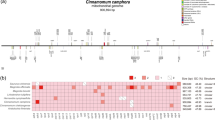Abstract
The woodrush genus Luzula is characterised by having holocentric chromosomes. DNA of nine related Australasian species shows similar satellite DNAs which re very similar in nucleotide sequence content and unit length. Differences between the repetitive DNAs are evident as either the presence or absence of particular restriction enzyme sites. Sequence variants have probably been introduced into the repeated DNA components of ancestral species and particular variants reamplified during the evolution of the genus. Sequence amplification appears to be restricted to sequences already present in the genome rather thant the de novo generation of repeats. The evolution of highly-repeated DNA sequences dispersed throughout the holocentric chromosomes of Luzula thus appears to be very similar to that known in eukaryotes with the more normal monocentric chromosome organisation.
Similar content being viewed by others
References
Arnold, M. L. & Shaw, D. D., 1985. The heterochromatin of grasshoppers from the Caledia captiva species complex. Chromosoma 93: 183–190.
Barnes, S. R., James, A. M. & Jamieson, G., 1985. The organisation, nucleotide sequence, and chromosomal distribution of a satellite DNA from Allium cepa. 92: 185–192.
Barnes, S. R., Webb, D. A. & Dover, G. A., 1979. The distribution of satellite and mainband DNA components in the melanogaster species subgroup of Drosophila. I. Franctionation of DNA in actinomycin-D and Distamycin-A denisty gradients. Chromosoma 67: 341–363.
Bendich, A. J. & Anderson, R. S., 1977. Characterisation of families of repeated DNA sequences from four vascular plants. Biochemistry 16: 4655–4663.
Collet, C., 1982, Highly-repeated DNA in Luzula: An organism with holocentric chromosomes. Ph.D. thesis, La Trobe University.
Collet, C., 1984. Highly-repeated DNA and holocentric chromosomes of the woodrush Luzula flaccida (Juneaceae). Canad. J. Genet. Cytol. 26: 288–295.
Collet, C. & Westerman, M., 1984. Interspersed distribution patterns of C-bands and satellite DNA in the holocentric chromosomes of Luzula flaccida (Juncaceae). Genetica 63: 175–179.
Donehower, L. & Gillespie, D., 1979. Restriction periodicities in highly repetitive DNA of primates. J. mol. Biol. 134: 805–834.
Dover, G. A., 1980. Problems in the use of DNA for the study of species relationships and the evolutionary significance of genomic differences. In: Chemosystematics: practice and principles (F. A.Bisby, J. G.Vaughn & C. A.Wright, eds.) Systematics Association Special Volume 16: 241–268, London, Academic Press.
Edgar, E., 1975. Australasian Luzula. N.Z.J. Bot. 13: 781–802.
Flavell, R. B., O'Dell, M. & Smith, D. B., 1979. Repeated DNA sequence comparison between Triticum and Aegilops species. Heredity 42: 309–322.
Flavell, R. B., Rimpau, J., Smith, D. B., O'Dell, M. & Bedrook, J. R., 1980. The evolution of plant genome structure. In: Genome organisation and expression in plants (C. J. Leaver ed.), NATO Advanced Institute Series A28: 35–47.
Gall, J. G. & Atherton, D. D., 1974. Satellite DNA in Drosophila virilis. J. mol. Biol. 85: 633–664.
Heguay, A., Musto, H. & Wettstein, R., 1982. Comparative DNA analysis of three South American marsupials. Nuc. Acids Res. 10: 5967–5978.
Lohe, A. R. & Brutlag, D. L., 1986. Multiplicity of satellite DNA sequences in Drosophila melanogaster. Proc. natn. Acad. Sci. U.S.A. 83: 696–700.
Miklos, G. L. G. & Gill, A. C., 1982. Nucleotide sequences of highly-repeated DNAs: compilation and comments. Genet. Res. (Camb.) 39: 1–30.
Mitchell, A. R., Gosden, J. R. & Ryder, O. A., 1980. Satellite DNA relationships in man and primates. Nuc. Acids Res. 9: 3235–3248.
Nordensklöld, H., 1951. Cytotaxanomical studies in the genus Luzula. I. Somatic chromosomes and chromosome numbers. Hereditas 37: 325–355.
Nordenskiöld, H., 1969. The genus Luzula in Australia. Bot. Notiser 122: 69–89.
Peacock, W. J., Dennis, E. S., Elizur, A. & Calaby, J. H., 1981. Repeated DNA sequences and kangaroo phylogeny. Aust. J. biol. Sci. 34: 325–340.
Schmookler-Reis, R., Timmis, J. N. & Ingle, J., 1981. Divergence, differential methylation and interspersion of melon sattellite DNA sequences. Biochem. J. 195: 723–734.
Southern, E., 1971. Effects of sequence divergence on the reassociation properties of repetitive DNAs. Nat. New Biol 232: 82–83.
Strachan, T., Webb, D. & Dover, G. A., 1985. Transition stages of molecular drive in multiple copy DNA families in Drosophila. EMBO J. 4: 1701–1708.
Venolia, L. & Peacock, W. J., 1981. A highly-repeated DNA from the genome of the wallaroo (Macropus robustus robustus). Aust. J. Biol. Sci. 34: 97–113.
Author information
Authors and Affiliations
Rights and permissions
About this article
Cite this article
Collet, C., Westerman, M. Interspecies comparison of the highly-repeated DNA of Australasian Luzula (Juncaceae). Genetica 74, 95–103 (1987). https://doi.org/10.1007/BF00055219
Received:
Accepted:
Issue Date:
DOI: https://doi.org/10.1007/BF00055219




